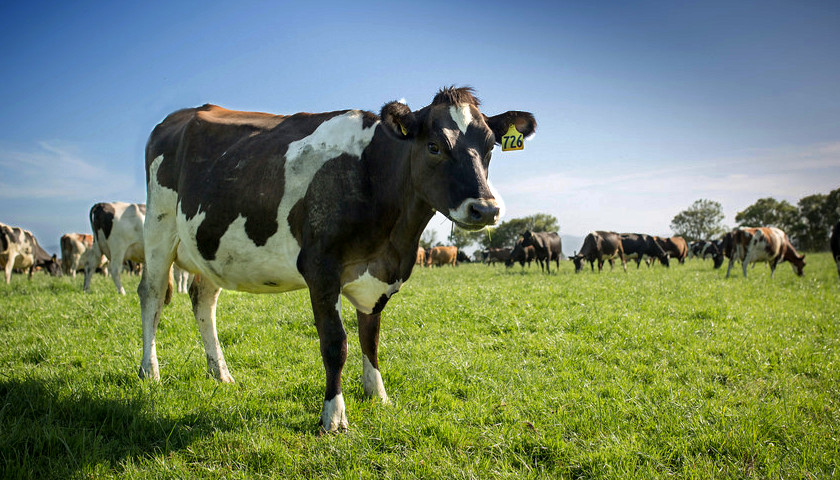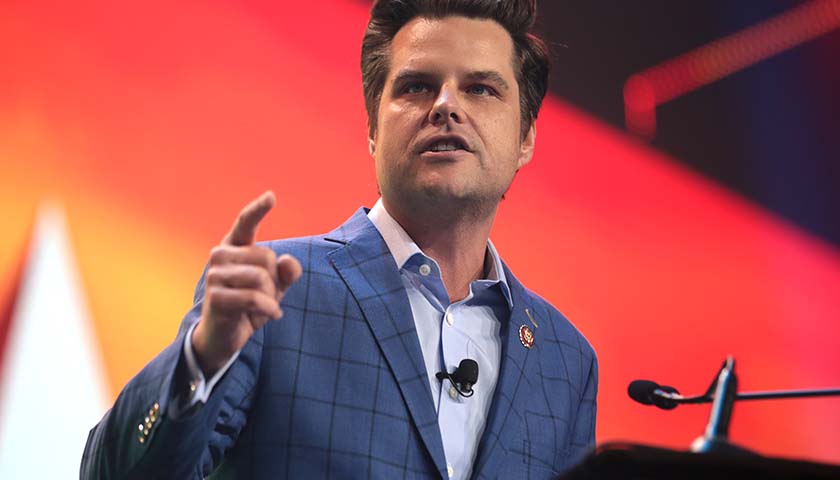by Andrew Kerr
– Dairy farmers are forced to pay a tax that funds nonprofits dedicated to boosting dairy sales
– One dairy farmer says the nonprofits are doing a “pretty piss poor job”
– The nonprofit that takes the most pays its top executives salaries so lavish they may violate IRS rules
Pennsylvania dairy farmer Brenda Cochran has weathered over $600,000 in losses to her mid-sized farm from a nearly 40 percent drop in milk prices since 2014.
Further compounding Cochran’s financial strain is her forced participation in the Department of Agriculture’s dairy checkoff program, which siphons up to $4,000 from her bottom line each year to fund a network of nonprofit organizations tasked with promoting the dairy industry through advertisements and the development of new products.
The organizations that receive her federally-mandated checkoff payments told Cochran that the program has had a “huge impact” on boosting dairy sales, primarily through the creation of new products for major fast food chains.
But Cochran isn’t buying it. She says the organizations she’s forced to fund are doing a “pretty piss poor job” doing anything to support struggling dairy farmers.
 The nonprofit that receives the largest share of dairy checkoff dollars has used the funds to finance ineffective promotion campaigns and has diverted millions of dollars toward lofty compensation packages for its top executives, a Daily Caller News Foundation investigation has found.
The nonprofit that receives the largest share of dairy checkoff dollars has used the funds to finance ineffective promotion campaigns and has diverted millions of dollars toward lofty compensation packages for its top executives, a Daily Caller News Foundation investigation has found.
“It is a total scam,” Cochran told TheDCNF. “They have forced us to finance research for products that are benefiting fast food joints and pizza parlors. I’m helping develop R&D for them when I can’t even pay my basic agrarian costs on the farm.”
“This is special interests targeting dairy farmers to contribute to our own demise,” Cochran said.
Cochran is just one of the many dairy farmers struggling to stay afloat in a market that’s reached a crisis point. Four years of rock-bottom milk prices have led to fears of dairy farmer suicides, and nearly 17,000 dairy farms have closed shop in the past decade, according to the USDA, dropping the total number of farms nationwide to just over 40,000.
All the while, the federal government forces dairy farmers to contribute hundreds of millions of dollars a year to the dairy checkoff program, supposedly for their collective good.
Struggling Dairy Farmers Forced To Subsidize Fast Food Restaurants
The dairy checkoff program is funded by what amounts to a 1 percent tax on raw milk sold at current prices — the federal government strips 15 cents from dairy farmers for every 100 pounds of dairy sold to fund the program. Dairy farmers collectively paid $332 million into the checkoff in 2016 alone, according to the Government Accountability Office.
Checkoff payments are divvied out between 65 state, regional and national USDA-authorized organizations. The largest recipient is Dairy Management Inc. (DMI), the nonprofit organization that manages the dairy checkoff at the national level.
Farmers pumped $1.21 billion into DMI from 2008 to 2016, much of which was spent researching and developing new products for Domino’s, Pizza Hut, Taco Bell and McDonald’s, according to tax documents and audited financial statements TheDCNF reviewed.
“Since the start of these partnerships in 2009, their combined milk equivalent tonnage has grown by 1.8 billion milk pounds,” DMI states of its fast food partnerships in its 2016 990 tax form.
While 1.8 billion pounds seems impressive on the surface, when put into the proper context, it barely represents a drop in the bucket. That figure represents a little more than one-tenth of one percent of the 1.6 trillion pounds of milk produced in the U.S. between 2009 and 2016, according to the USDA Economic Research Service.
Perhaps the most famous story linked to DMI is the “Got Milk?” campaign. The iconic milk mustache ad campaign is considered one of the greatest marketing taglines ever.
But “Got Milk?” didn’t sell more milk. In fact, per-capita fluid milk consumption dropped 24 percent between the time “Got Milk?” launched in 1993 and was dropped in 2014, according to USDA data.
“‘Got Milk?’ may have won awards for creativity, but it didn’t sell any more milk,” Pete Hardin, the publisher of The Milkweed newsletter and who’s widely considered one of the most knowledgeable experts on the U.S. dairy industry, told TheDCNF.
“Per-capita milk consumption has gone down,” Hardin said. “Is this program working? Heck no.”
DMI’s Executives Are Among The Nation’s Highest Paid Nonprofit Employees
Dairy farmers’ federally-mandated checkoff payments are also used to provide lavish compensation packages to DMI’s top executives, according to tax documents and audited financial statements reviewed by TheDCNF.
DMI’s top earner from 2008 to 2016 was CEO Tom Gallagher, who brought home a combined $8.3 million during that timeframe — an average yearly compensation of nearly $924,000.
(Graph: Daily Caller News Foundation/Andrew Kerr)
Gallagher’s annual base compensation of $385,000 in 2008 ballooned to $575,000 by 2016 — a 49 percent increase.
But Gallagher’s total base pay of $4,140,000 from 2008 to 2016 represents only half of his total compensation package. The other half is attributable to $345,000 in bonuses, $162,125 in nontaxable benefits, $748,176 in deferred compensation and a whopping $2,917,172 in “other reportable compensation,” according to DMI’s 990 tax forms.
Much of Gallagher’s “other” compensation came in the form of a lucrative supplemental retirement plan benefit, the documents show. Gallagher’s supplemental retirement plan is paid on top of his regular retirement benefit and in one year paid more than his base salary.
In 2013, Gallagher earned $483,879 through his supplemental retirement benefit, which was more than his base pay of $462,500 that same year. On top of that, the DMI CEO collected an additional $112,569 in other retirement and deferred compensation benefits.
The average CEO of a nonprofit with a budget over $50 million — like DMI — made $634,217 in 2015, according to nonprofit watchdog GuideStar’s latest compensation report. Gallagher’s compensation that year of $1,361,753 more than doubled that figure.
Gallagher’s chief lieutenants at DMI also make far more than the average nonprofit executive. In 2015, for example, DMI’s top eight executives under Gallagher made a combined $5,423,997 — an average compensation package of $678,000 per executive, which is more than double the $295,686 earned by the top administrator at the average nonprofit with a budget over $50 million in 2015, according to GuideStar.
Meanwhile, the dairy farmers the federal government forces to bankroll DMI’s lavish executive salaries are struggling to stay afloat with milk prices remaining especially low for their fourth year.
“I can’t pay utilities, I can’t pay for health insurance or my feed bills,” Cochran told TheDCNF. “There are millions of dollars going out of the dairy economy every year to provide these perks for the upper-ups.”
“But that is what I’d expect from a program rooted in corruption and malfeasance and the abuse of the dairy farmer class,” she said.
DMI’s Excessive Executive Compensation Could Be Violating IRS Rules
DMI representative Scott Wallin explained in a statement to TheDCNF how the organization determines compensation for its executives.
“Salaries at DMI are within competitive levels of compensation for comparable positions,” he said. “This was confirmed by comprehensive, independent surveys.”
“DMI recruits from the same talent pool as for-profit consumer product goods companies and advertising and public relations agencies and marketing firms,” Wallin continued. “Many of these companies offer stock options and other benefits that are not available through checkoff organizations.”
It’s unclear why DMI uses salary data from for-profit organizations to set its executive pay rather than comparing compensation levels from the 21 other checkoff programs the USDA oversees.
The other checkoff programs are funded the same way as the dairy checkoff. Farmers of pork, beef, eggs, peanuts, cotton and other agricultural commodities are federally mandated to pay a tax to their respective checkoff after every sale to fund research and promotion for their product.
The $1.3 million Gallagher earned in 2015 as DMI’s CEO was nearly 400 percent greater than the $273,000 earned that year by the average CEO of the other national checkoff organizations, according to a compensation report by Agri-Pulse.
Hardin, the dairy expert, said DMI’s executives are earning so much that the organization could be in violation of IRS rules.
The IRS states that nonprofit organizations must pay its executives “fair and reasonable” compensation, according to GuideStar. Penalties for violations range from fines imposed on the overpaid executives to the revocation of an organization’s tax-exempt status.
“The IRS specifies very clearly that nonprofit executive salaries must be within a common range of similar organizations,” Hardin told TheDCNF. “There’s no similarity here, no matter what kind of baloney DMI tries to feed you.”
DMI did not respond when asked if executive compensation levels at the other checkoff programs are considered when determining its own compensation packages.
Dairy Farmers Are Federally Mandated To Fund DMI
Farmers who refuse to pay into the checkoff, which is used to finance DMI’s fast food partnerships and lavish executive salaries, face fines and interest charges from the federal government.
The Dairy Act of 1983 mandated that dairy farmers pay into the checkoff.
“This bureaucracy was created without farmers having a vote on process,” Hardin told TheDCNF. “I think if a vote were put up to the farmers right now, they would vote ‘no’. They don’t want to see this money continuing to be wasted on fancy-pants programs and salaries.”
National Dairy Producers Organization Chairman Mike Eby also told TheDCNF: “Obviously there’s a problem here. Dairy farmers don’t like it, but yet they have very little voice in the matter because they’ve, in essence, been hijacked. They can’t even speak up at their co-op level out of fear of termination.”
“They’ve been hijacked, I don’t know a better way to describe this,” he continued.
The Checkoff Program Led To Major Developments, Like Taco Bell’s Quesalupa
Cochran is one of the few dairy farmers to take a stand against the checkoff program. She successfully argued before the Third Circuit Court of Appeals in 2004 that her forced participation in the checkoff was a violation of her First Amendment right to refrain from paying for speech she disagreed with.
But in 2005, the Supreme Court ruled in a separate case that the USDA’s checkoff programs were “government speech.” That paved the way for DMI to use checkoff dollars to develop revolutionary new products like Taco Bell’s cheese-packed Quesalupa.
“In 2016 DMI led a major breakthrough for Taco Bell in leading the development and launch of the Quesalupa,” the group’s 990 tax form that year said, boasting that the item would feature “five times as much cheese as a regular crunchy taco.”
“Taco Bell had the idea for the Quesalupa years ago, but was unable to produce it until the on-site [DMI] scientist, backed by dairy farmer funding of consumer research and product testing, was able to bring the Quesalupa to life,” it continued.
And the dairy farmers who were forced to fund the development of the Quesalupa and other fast food products don’t receive a portion of the profits generated from their investment.
“It is outrageous that they add to my farm operation a business cost that I am not allowed to recoup from the marketplace,” Cochran told TheDCNF.
“I produce raw milk. I have to deal with vets and taxes and fees and feed corn — all the things that go with taking care of animals and planting crops,” Cochran said. “And they want me to develop cheese and yogurt? I’m very upset about it. Even just talking about it makes my blood pressure go up.”
– – –
Andrew Kerr is a reporter at Daily Caller News Foundation. Follow Andrew on Twitter.




